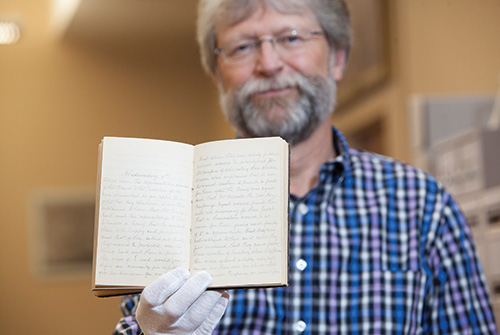

When Queen’s Archivist Paul Banfield, MA’85, boarded a plane in Timmins, Ontario, last July for the 50-minute journey to Moose Factory, he was only there as an escort. The real traveler was a small, well-weathered black diary from the University Archives. As a historically significant document, the book had been invited to make an appearance at the James Bay Treaty – Treaty No. 9 conference hosted by the Moose Cree First Nation.
 Queen’s Archivist Paul Banfield displays the MacMartin diary.
Queen’s Archivist Paul Banfield displays the MacMartin diary.
Penned in 1905, the diary belonged to Daniel George MacMartin (1844-1923) who, at the time, served as Ontario’s Treaty Commissioner. That same year, the federal government was negotiating Treaty No. 9 – a.k.a. “the James Bay Treaty” – for land rights in the area. MacMartin and two federal representatives went to carry out the negotiations and have the northern community’s Chiefs and Elders sign the document. One of their stops was Moose Factory, a former Hudson Bay trading post with a current population of less than 2,500.
“It was clear neither side understood the other, and as a result, much was lost in translation,” says Banfield about the negotiations.
He explains that while all three government men kept diaries, only MacMartin’s pencil-script account, clearly outlined those difficulties.
That’s why the diary, donated to Queen’s in 1968 as part of a larger estate gift and “rediscovered” by researchers in 1995, has become a vitally important piece of evidence from a First Nations perspective, particularly as court cases dissect and determine the merits of the original treaty.
 The MacMartin diary was displayed alongside Treaty No. 9, in Moose Factory this past summer.
The MacMartin diary was displayed alongside Treaty No. 9, in Moose Factory this past summer.That’s also the reason the record was accorded a place of prominence at this summer’s conference, where it was displayed alongside the original Treaty No. 9 parchment – likely the first time since 1905 that the two documents had come together.
The conference attracted people from the Moose Factory area. “One of the tribal Elders told me that he saw the diary as a new Bible,” says Banfield. “Everyone viewed the diary with great reverence and respect, as they did the treaty. I found it a moving experience to be there.”
The MacMartin diary is now safely back home in the Archives where it is available for study by scholars.
While the MacMartin diary’s historic value is clear, its last three pages are decidedly not. Written in pencil, their contents have been erased – although the reason isn’t known. Curious to know what was deleted, the Queen’s Archives staff called on Dr. George Bevan (Classics), to investigate. Bevan, who specializes in using technical photography (including ultraviolet and infrared), to help decode ancient texts and archeological finds, was happy to take on the forensic challenge. He knew, however, that the task wouldn’t be an easy one. Reading faded ink would have been a relative breeze; erased pencil is notoriously difficult to decipher. While Bevan and student Ian Longo, Artsci’14, have so far managed to make out a few more words, the results of their investigation have largely been inconclusive. They’re now hoping to partner with a criminal forensics lab for a more in-depth look. – MD
(Correction: An earlier version of this article stated that MacMartin was alive from 1870-1921.)